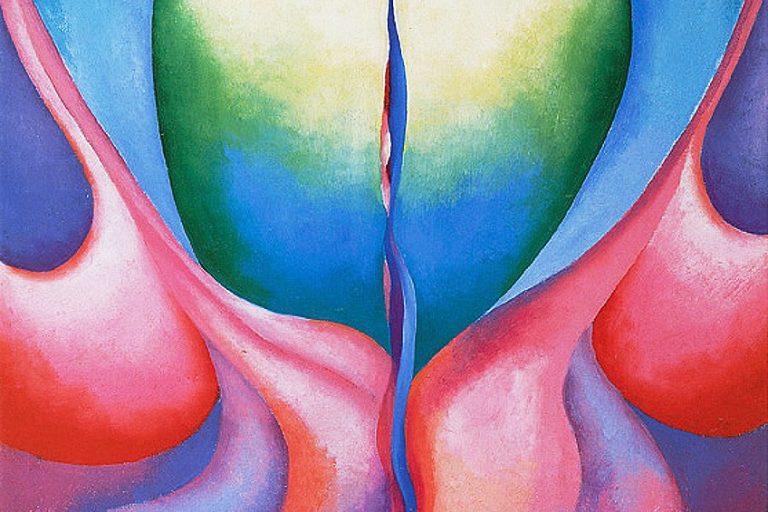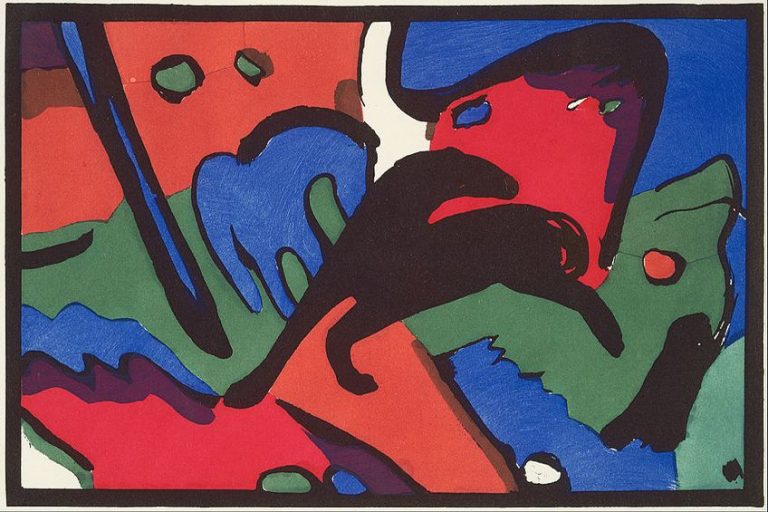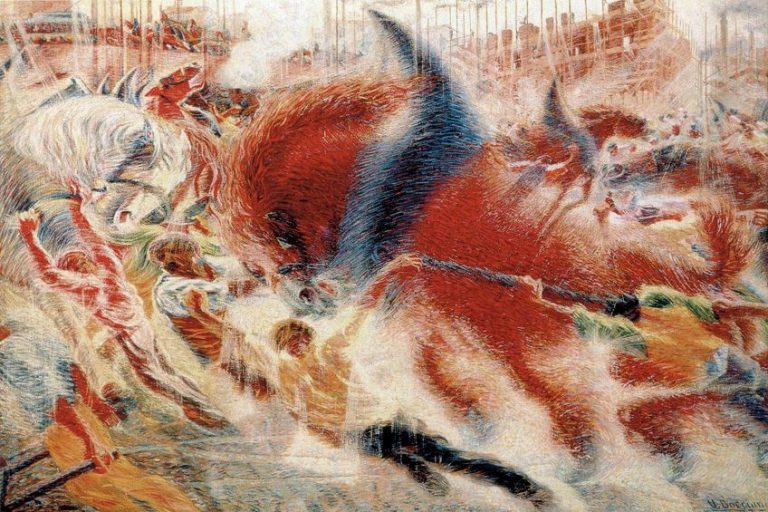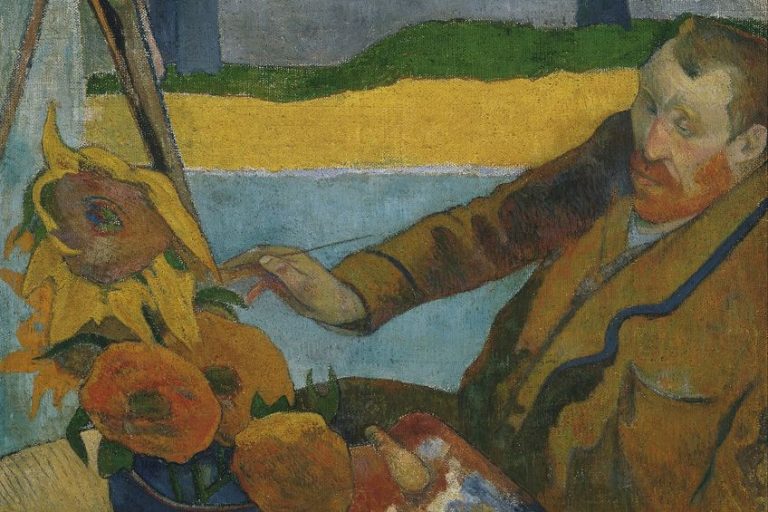Persian Art – A History of Ancient Persian Paintings and Iranian Art
Persian art, also referred to as Iranian art, is an art form made up of many mediums that include painting, pottery, sculpture, metalworking, calligraphy, weaving, and architecture. As the historic region of Persia developed, Persian art gave and received multiple influences from neighboring countries, which impacted the style seen in the artworks created. With the earliest influence dating back to approximately 550 BCE, Persian art exists as one of the richest art heritages in the world.
A History of Persian Art
In what is now known as Iran, the region of Persia created an immense empire in the second half of the 6th century BCE that spanned the Indus Valley to Northern Greece, as well as Central Asia to Egypt. Thought to begin with the First Persian Empire, known as the Achaemenid Empire that occurred between 550 and 330 BCE, the Persian art era is said to have one of the longest histories of origin in the art world.
During its inception, Persian art took inspiration from older civilizations such as Mesopotamia, with which it continued to mingle for much of Antiquity. The impact that this had on Persian art was that a rich cultural history began to develop, which could be seen in the artworks that were created. First established by Emperor Cyrus the Great, Persia existed as a vast empire over three general phases, which saw the region extending its rule into Central Asia and throughout Asia Minor.

Known to be one of the oldest countries in the world, Persia was home to one of the earliest cultures and societies that were believed to experiment with artmaking. Early Persian artworks included intricate ceramics and small bronze objects, which displayed a variety of artistic styles and influences that were taken from bordering countries.
Throughout its domination, Persian art was influenced by Sumerian Art, Greek Art, and especially Chinese Art. The impact of traditional Chinese characteristics became visible in the creation of Persian miniatures, which existed as small paintings that were done on paper as either a book illustration or an individual work of art. These miniatures were made to be kept in an album of miniature works known as a muraqqa. Today, Persian art miniatures encompass some of the most significant Persia paintings from that period of art history.
The term “Persia” was derived from an area of southern Iran that was formerly known as “Persis” or “Parsa”. This region was named after the Indo-European nomadic group of individuals who had migrated to that region in 1000 BCE. However, in 1935, the Iranian government requested that all countries with which it had diplomatic ties refer to the country by its Persian name, which is Iran.
Due to this, Persian art and Iranian art have been used interchangeably, as the term essentially denotes the same thing.
When considering the development of Persian art, the artworks created can stylistically be represented as a blend of Native Persian traditions with Mesopotamian, Egyptian, and classic Greek and Roman art. This was because as each new culture appeared in Persia, the art that emerged borrowed heavily from the culture of older civilizations. Despite this borrowing, each external influence that appeared in Persian art was understood and translated in a uniquely Persian way to create the extraordinary art that existed.
Due to this, the surviving Persian art to come from ancient times placed a strong focus on the human figure, as most monuments from this era depicted males who were mostly royalty. Additionally, animals were also considered to be of great importance, as the emphasis was placed on them in these sculptures as well.
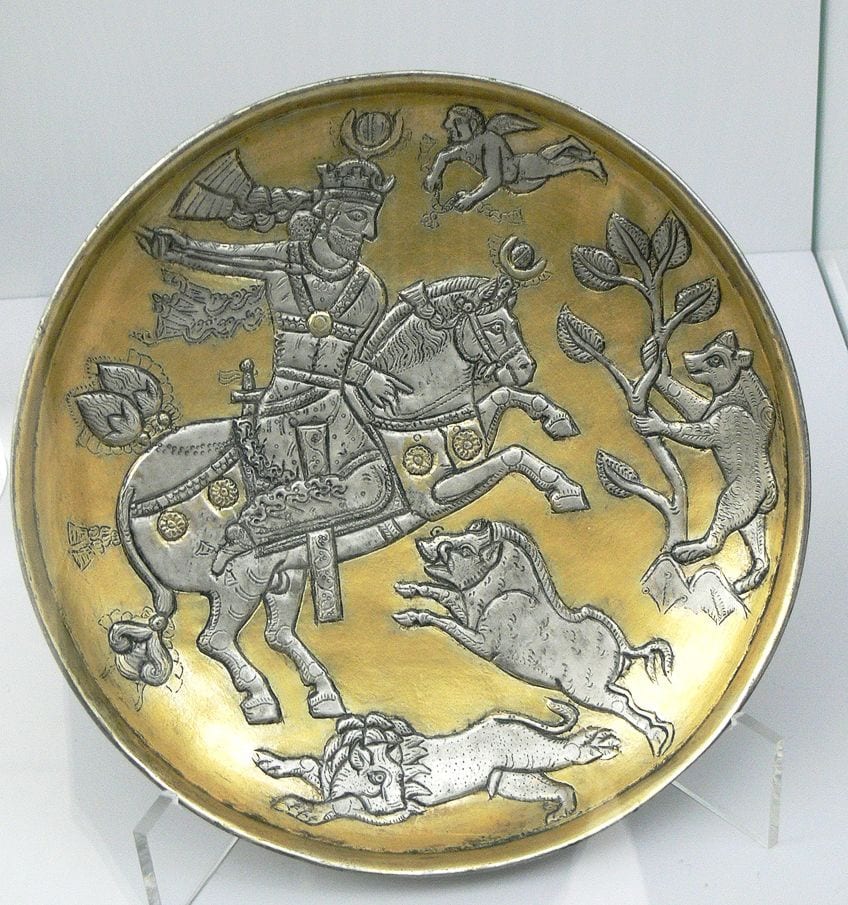
However, with the fall of the First Persian Empire, Islam began to form as the dominant religion in Persia. As time progressed, an Islamic style of art began to develop, which further influenced the type of sculptures and artworks that were created. Animals began to be represented on a much smaller scale in comparison to the plants that surrounded them and were also combined with elegant Chinese motifs, as the focus of Persian art turned towards an extremely graceful and harmonious style.
Unfortunately, relatively little Persian art that was created has managed to survive the millennia. The architecture that has been preserved is mostly made up of broken palaces and rock-cut tombs today, while some of the iconic Persian sculpture has been maintained in column capitals, wall reliefs, and metalworks. Possibly the greatest misfortune from this rich period of art history is that no remnants of the countless ancient Persian paintings exist today.
Early Persian Art
The history of Persia and its art appeared over three great phases in the region’s development. Within those phases, two great ages of Persian civilization developed, which were subsequently recognized as the First Persian Empire, which was known as the Achaemenid Empire, and the Second Persian Empire, which was the Sassanid Empire. The third phase existed as more of a transitory stage between the two empires and was labeled the Parthian Era.
Prior to the appearance of the Achaemenid Era, Persian culture was in its more formative stages of development. Therefore, with the rise of each empire, Persian art was slowly influenced by the influx of different cultures and ideas.
At the fall of the Sassanid Era, Persia became part of the Islamic world, where it has been ever since. Thus, the art that emerged from this last stage is described to have a decidedly Islamic influence due to the changes and advancements that occurred within the civilization in Persia at that time.
Achaemenid Era (c. 550 – 330 BCE)
Founded by Cyrus the Great, the Achaemenid Era was known as the First Persian Empire to exist. It spanned between approximately 550 and 330 BCE and was primarily influenced by both Greek and Egyptian art. Artworks to come out of the Achaemenid Empire drew on models of the past in an effort to improve them, with architecture existing as the main form of art that was created and regenerated during this time.
Persian art within the First Empire was best illustrated by a series of monumental palace complexes that were built in Persepolis, the capital city, and Susa. These palaces were typically adorned in sculpture and elaborate stone bas-reliefs, as the Achaemenids worked mainly in stone. An important enameled brick decoration, the Archers frieze of Susa, which adorned the royal palace of Darius I (r. 522-486 BCE) in Susa is still in existence today, demonstrating the style of stonework that was popular. It is on display at the Louvre Museum in France.
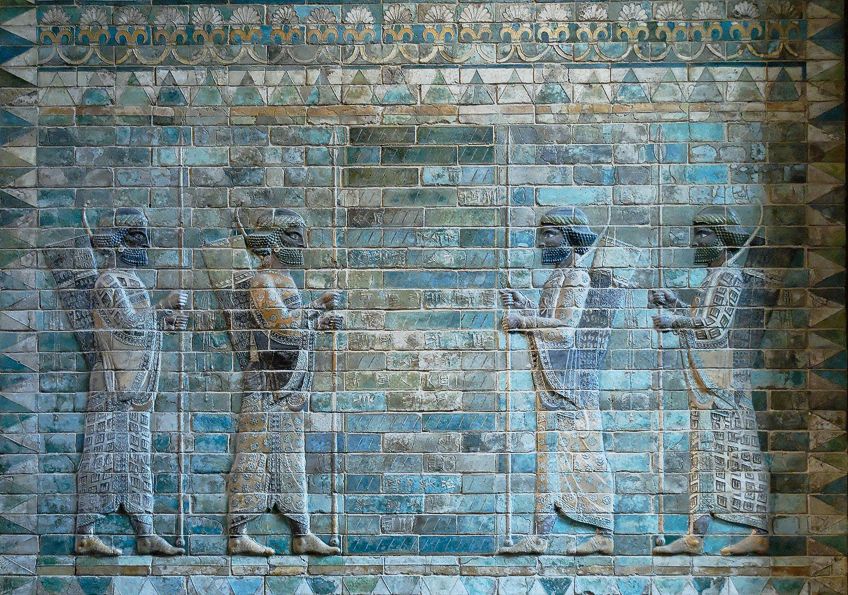
Other sculptures present within the city of Persepolis were a pair of large bulls with human heads, which flanked the gates leading into the city. Darius I, the ruler at that time, was also said to have commissioned an enormous relief sculpture carved out of rock complete with an inscription. Within the sculpture, he is portrayed to be conquering his enemies while being watched over by the Gods.
This sculpture thus demonstrated the great influence that Greek art had on the type of sculptures created within the Achaemenid Era.
Other important artworks from the First Persian Empire included intricate jewelry which was typically made out of precious metals like gold and gemstones. This complex jewelry went on to illustrate the outstanding level of artistry that existed during this time, which was further emphasized by the swords and drinking horns that were made out of silver and gold.
Parthian Era (c. 247 BCE – 224 CE)
After the fall of the Achaemenid Empire in 330 BCE to Alexander the Great, Persian art was soon replaced by the Parthian Era. This existed as a temporary stage between the First and Second Persian Empire and ended up spanning from about 247 BCE until 224 CE. This led to an uncomplimentary mix of Greek and Iranian motifs in the art that was created, with Greek culture dominating momentarily.
However, after the death of Alexander the Great, Persian art fell fully under the influence of the Parthians, which helped resume the development of Persian art and architecture. The Parthians initially existed as semi-nomadic people, with the style of the artwork indicating the many different regions that had come into contact with them. Despite this diversity present in the sculptures and monuments, art from the Parthian Era retained some basics that were established in previous Achaemenid artworks.
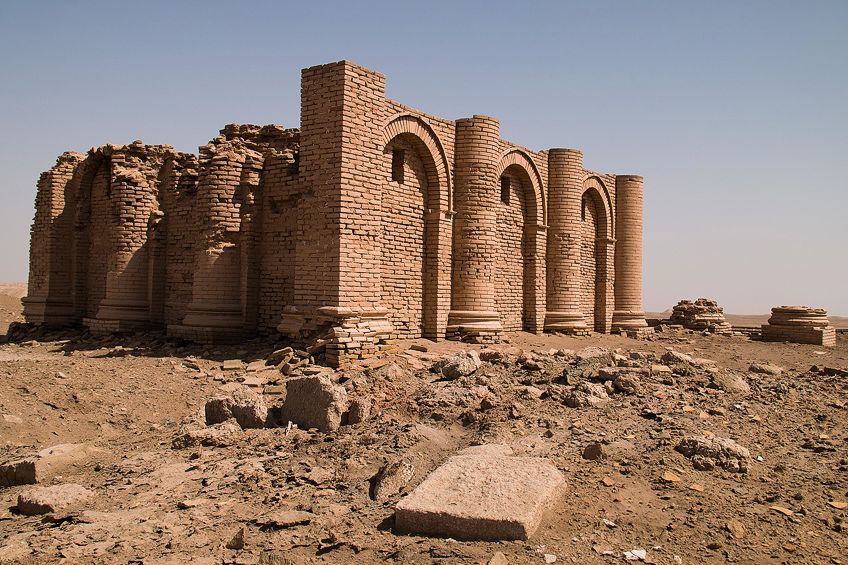
The main characteristic found in art from the Parthian Era was an inevitable return to architecture and a frontality in art. Ancient Persian paintings and sculptures no longer featured images of people from their side profile only, as they were replaced with statuary images that confronted viewers head-on.
Parthian art and architecture were said to be greatly influenced by Hellenistic and Mesopotamian forms, which were drawn upon by these nomads to make art that was entirely their own. For example, the domes that were built took inspiration from stable Roman art but were expanded on by the Parthians. Roman domes were placed on top of structures, whereas Parthian domes were made to rise from the earth directly.
The era of Parthian art eventually reached its peak as the Second Persian Empire, known as the Sassanid Empire, began. Despite existing as a momentary interlude between the two empires, the Parthian Era was incredibly influential to the development of Persian art, as it was continuously referred back to in order to create some of the most important monuments and works of art of the ancient world.
Sassanid Era (c. 226 – 650 CE)
The Second Persian Empire, known as the Sassanid Era, came into existence after the Parthian Era, roughly lasting between 226 CE until about 650 CE. This period of art was thought to be remarkable, as it managed to rebuild much of Persia’s power and culture that was lost before. The Sasanian Empire was established by Ardashir I (c. 224- 240 CE), a general for the Parthians, who managed to overthrow the last Parthian king and form his own dynasty.
Once the Sassanid Era emerged, Ardashir I launched various building projects which have survived the length of time and exist as some of the best examples of Sasanian art today. Two important designs became architectural staples during this period, which were the dome and the minaret. However, what made these designs stand out was that Sasanians abandoned the frontality of sculptures embraced within the Parthian Era and returned to the profile and three-quarter view treatment commonly used in the Achaemenid Era.

Sasanian art focused on decorative stone mosaics and created dishes typically made out of gold and silver that depicted animals and various hunting scenes. However, possibly the most striking Sasanian art to develop from this era were rock sculptures that were carved out of sharp limestone cliffs. These sculptures were etched out to illustrate the many victories of the various Sassanid leaders at that time.
An important artistic craft that came out of the Second Persian Empire, which is still in use today, was carpet-making and silk-weaving. This skill led to the development of the iconic Persian carpets, which were exported to the West in what is now known as Istanbul and to the East to Turkey.
The Sasanian Empire continued to draw on the knowledge and influences of previous artistic eras, as this period fully integrated techniques that worked in the past into their present style to be used and improved upon.
Thus, Sasanian art is easily considered to be the peak of Persian artistic effort, as it illustrated and emphasized the best aspects of the ancient Persian culture into the sculptures and artworks that were created.
Persian Architecture
The architecture that developed during the era of Persian art was incredibly important, as it led the way to great developments which can still be seen today. Out of the various empires that ruled over Persia, the richest collection of architecture is said to be found in the ruins of the Persepolis, which was built during the Achaemenid Era. Persepolis was considered to be the capital of Iran during the First Persian Empire, with the subsequent empires attempting to emulate the type of architecture that was built.

When considering the distinctive characteristics that came out of Persian architecture, the column exists as an important feature. Although formed after the Greek columns, Persian artists and sculptors added a unique twist to their columns, which made them distinctly their own. Persian columns were thinner, which elongated their sense of verticality, and had an unusual topmost section design, Termed the Persian animal capital, it greatly differed from Greek columns as it featured the front of an animal emerging from both sides of the column.
Additionally, the column differed between the First and Second Persian Empire. Within the Achaemenid Empire, columns featured a post-and-beam support structure, while the Sassanid Empire made use of an arched support construction, inspired by the Romans.
Despite the influences taken from both Greek and Roman sculpture, the architecture of Persia remains one of the most remarkable artistic advances due to its own cultural impact throughout the different eras.
Persian Sculpture
One of the most important artistic developments within Persian art was sculpture. Luckily, numerous Persian sculptures have managed to survive as time has gone on, mostly in the form of the stone reliefs that were carved onto the walls of palaces and on the faces of cliffs. The influences for sculptures varied greatly, with some remaining Persian sculpture pieces demonstrating a strong Mesopotamian influence, while others display strikingly classic European features.

Persian sculpture alternated between quite stylized and very realistic, with the features of a sculpture depending heavily on the culture of influence. Thus, two contrasting aesthetics made up the sculptures found within Persia, yet they were all universally considered to be uniquely Persian sculptures.
In addition to stone sculptures, Persia was also responsible for the vast amount of metalwork sculptures that emerged from this era, despite very few of these sculptures surviving the passage of time. Common forms that were sculpted out of metal included statuettes, jewelry, and rhytons, which were goblets and pitchers that featured an animal type of design.
Persia Under Islam
After the fall of the Sassanid Era, Persia was invaded by Arabs and became part of Islam as a result. Due to this, Persian visual arts developed according to the newer Islamic rules, which meant a shift in the artmaking process. One of these rules banned the depiction of three-dimensional living things, which led to an instantaneous decline in the creation of Persian sculpture.
This forced artists to adopt fine painting as their main artistic medium, with artworks becoming more decorative and flatter due to the influence of the Byzantine period.
Despite the production of sculpture diminishing, decorative arts which included metalwork, weaving, and ceramics continued to thrive. This led to artists focusing on ornamentation pieces that were eventually used to adorn Islamic temples such as the Mosque of Baghdad (764 CE), the Great Mosque at Samarra (847 CE), and the Imam Reza shrine in Mashhad (1418).
In addition to these decorations, mosaics were also widely used in mosques and in other buildings. Another popular style of Persian architecture, which continued in spite of Islamic rule, was creating colored roofs out of blue, red, and green-hued ceramic tiles.

The Rise of Illumination and Calligraphy
Due to the restriction placed on portraying three-dimensional living things, the creation of figure drawing and painting began to diminish. However, a popular Islamic art form that soon replaced drawing was Illumination. Developed in Persia, Illumination referred to the decoration of manuscripts and religious texts, in particular the Koran.
Iranian illuminators remained active during the late Middle Ages and reached their peak during the Safavid Dynasty that occurred between 1501 and 1722. Alongside Illumination, the rise in the reproduction of religious works inspired and accelerated the development of ornamental writing, which went on to be known as calligraphy.
Calligraphy existed alongside Illumination, with both forms of art eventually becoming known as Iranian art specialties.
The Development of Painting
Painting was considered to be an important form of art within Islamic Persia. The most important type of painting to emerge from this period of time was the Persian miniature paintings, which developed into a very significant art tradition in Iran.
The most important Persian miniature painter to emerge from this era was Kamāl ud-Dīn Behzād, whose artworks began to flourish towards the end of the 15th century. Well-known for his landscape paintings which he executed in an incredibly realistic style with the use of a vibrant color palette, Behzād went on to become the head of the Herat Academy of Painting and Calligraphy.
Behzād was said to take inspiration from depictions such as mountain-scapes and hunting scenes, which became increasingly popular during the 13th and 14th centuries. After Behzād’s extremely realistic paintings were created, portrait art started to develop and become fashionable in multiple artistic cultures. However, from the late 1600s onwards, Iranian art traditions began to weaken slightly due to artists attempting to mimic European painting styles.

Famous Persian Artists and Their Artworks
As Persian art existed as one of the oldest art forms to date, not many of the original artworks, sculptures, and textiles are still in existence today. Despite this, some iconic pieces are still spoken about and have managed to be preserved. Below, we discuss three important artworks to come from Iranian art.
The Oxus Treasure (c. 1877 CE)
The Achaemenid Empire was thought to have created one of the most iconic Persian sculpture collections to come from that time period, known as the Oxus Treasure. Within this hoard, which was discovered around 1877 CE and buried along the north bank of the Oxus River, contained magnificently crafted works including bowls, figurines, coins, statuettes, jewelry, jugs, and plaques of gold.
An important Persian sculpture found within the Oxus Treasure was the Gold Chariot, thought to be made between 600 and 400 BCE. The sculpture, which was entirely constructed from gold, featured a chariot that is open at the back and being drawn by four horses. Thought to come from the region of Takhi-Kuwad, Tajikistan, the Gold Chariot was influenced by the monumental style of gold and silver artworks made famous during the Achaemenid period.

Model chariot made of gold from the Oxus Treasure in the British Museum, 5th-4th century BC; British Museum, CC BY-SA 3.0, via Wikimedia Commons
The small horses appear to be pony-sized and have the appearance of ram-headed Nesaens, while the two figures driving the chariot are thought to be depictions of humans. Unfortunately, due to the vast period of time that passed since its burial, only nine of the horses’ legs have survived and the spokes in one of the wheels remain damaged.
Although the authenticity of this treasure has been contested many times throughout history, the general scholarly consensus remains that the artworks within the Oxus Treasure are genuine artifacts from the Achaemenid period.
It has also been theorized that the pieces were probably taken from a nearby temple and buried during one of the many tumultuous intervals of the region to keep safe.
Kamāl ud-Dīn Behzād (1455 – 1535)
An artist who created one of the most prominent Persia paintings throughout the region’s history was Kamāl ud-Dīn Behzād, who was alive between 1455 and 1535. Behzād was in charge of the royal workshops in Herat and Tabriz throughout the late Timurid and early Safavid Persian eras.
Behzād was regarded as an important influence on the development of miniature painting, which went on to be considered a great Persian tradition. One of his well-known miniature portraits, which he painted in 1500, was his Portrait of a Dervish, which displays the intricate detail that he included within his paintings.
Behzād went on to become a prominent director at the Herat Academy and was very revered for his position in the Royal Library in Herat. What made Behzād’s miniature paintings so unique were the common geometric aspects that he included, which he balanced with the inclusion of his own style. Behzād was renowned in his lifetime for his role as a painter, with his artworks receiving much acclaim.

Reza Abbasi (c. 1565 – 1635)
Another important Persian miniaturist was Reza Abbasi, who was considered the leading miniaturist of the Isfahan School during the later years of the Safavid period. Abbasi, who was alive between approximately 1565 and 1635, was considered to be one of the last impressive masters of Persian miniatures.
Abbasi was best known for his depiction of beautiful youths, as demonstrated in his painting titled Youth Reading, which was painted between 1625 and 1626. Within this painting, Abbasi demonstrated his infamous brushwork technique that can be seen in all his other Ancient Persia paintings. This delicate technique subsequently aided in the portrayal of a gentle beauty that was present in all his portraits.
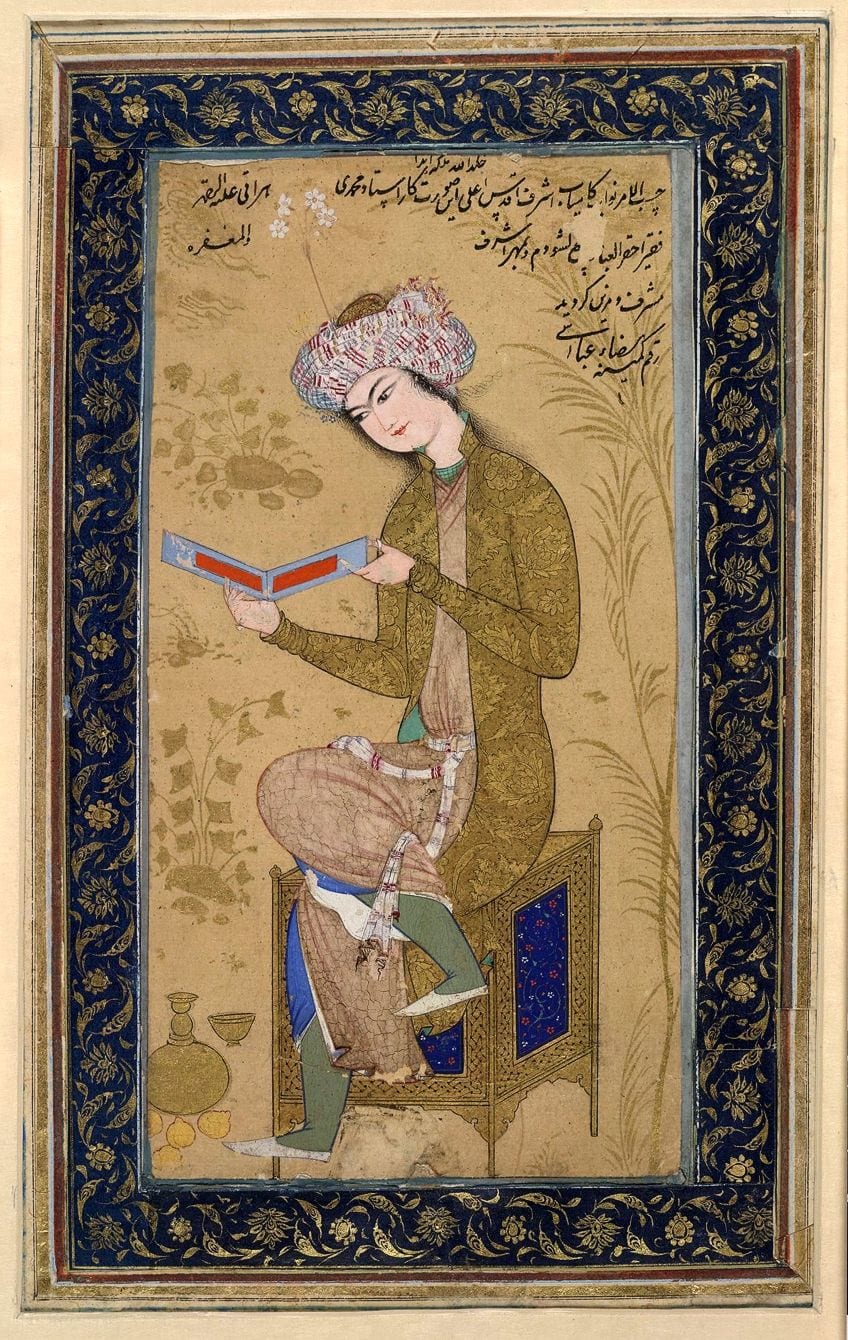
The Emergence of Persian Carpets
Carpet weaving is considered to be an essential part of Persian culture, in addition to being a significant Persian art form that still exists today. Due to their elaborateness, Persian carpets easily stand out due to their variety and the intricacy of the designs used. Although the term “Persian carpet” is most often used to refer to pile-woven textiles, carpets that are flat-woven like a Kilim and Soumak, as well as embroidered fabrics like Suzani, are also considered to fall part of the rich history of Persian weaving.
Persian carpets and rugs were traditionally woven by nomadic tribes in either village or town workshops as well as royal court manufacturers. Due to this, the carpets created represented different yet concurrent lines of tradition and typically reflected the history of Iran and its people within the patterns and designs chosen.
Within the 16th century, carpets woven by the Safavid court manufacturers of Isfahan were renowned for the elaborate colors and artistic designs used, making them treasured pieces in museum collections all over the world today.
These notable elements set out an aesthetic custom for court manufactories to follow when weaving carpets. These traditions were kept alive throughout the entire period of the Persian Empire and lasted as far as the existence of the very last royal dynasty of Iran. An example of one of these exceptional Safavid carpets, now housed in Copenhagen, Denmark, is the Coronation Carpet that was woven during the 17th century.
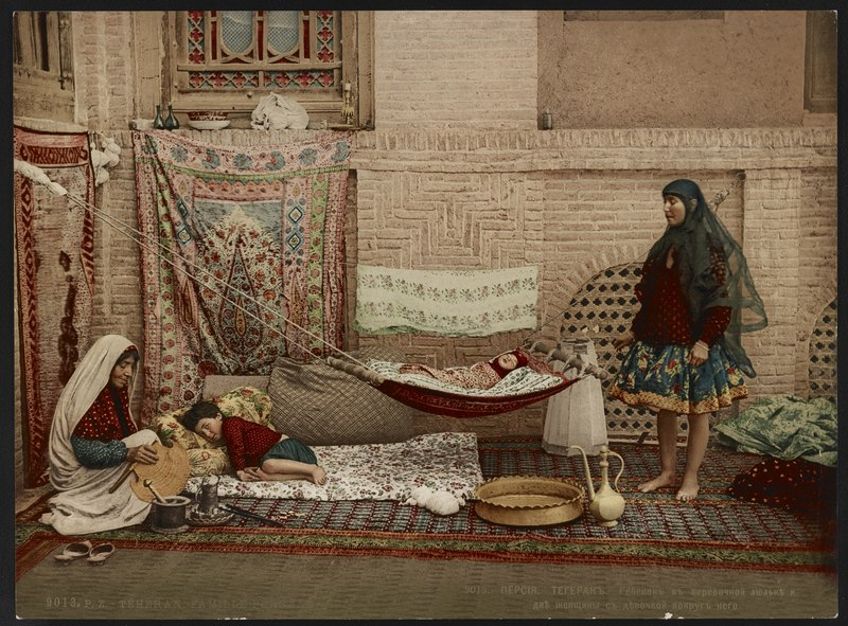
Carpets that were woven in important Iranian towns, such as Kashan, Mashhad, Kerman, and Isfahan, were all characterized by precise weaving techniques and the use of distinct colors, patterns, and superior materials. Some conventional characteristics of Persian carpets included the use of fine wool, vivid and elaborate colors, and specified, traditional patterns, with carpets woven today still capturing the importance of these elements.
The art and craft of carpet weaving suffered during times of political unrest and under the control of commercial demands. In particular, Persian carpet weaving suffered greatly from the introduction of synthetic dyes during the second half of the 19th century.
However, carpet weaving has slowly been brought back into modern Iran, with towns such as Tabriz playing a significant historical role in restoring this tradition of carpet weaving after many years of decline.
This form of ancient Persian arts has been reinvented in the modern era, with the revival of traditional and natural dyes, in addition to the reintroduction of tribal patterns and contemporary, inventive designs. Today, Persian carpets are considered to be objects of great artistic and functional value, just as they were in the past.
Throughout its history, Persia remained famous for the textiles that were produced, with traditional Persian carpets going on to become one of the most well-known art forms still in existence today. In 2010, the traditional skills of carpet weaving originating from the Fars and Kashan regions in Iran were registered into the UNESCO Intangible Cultural Heritage Lists.
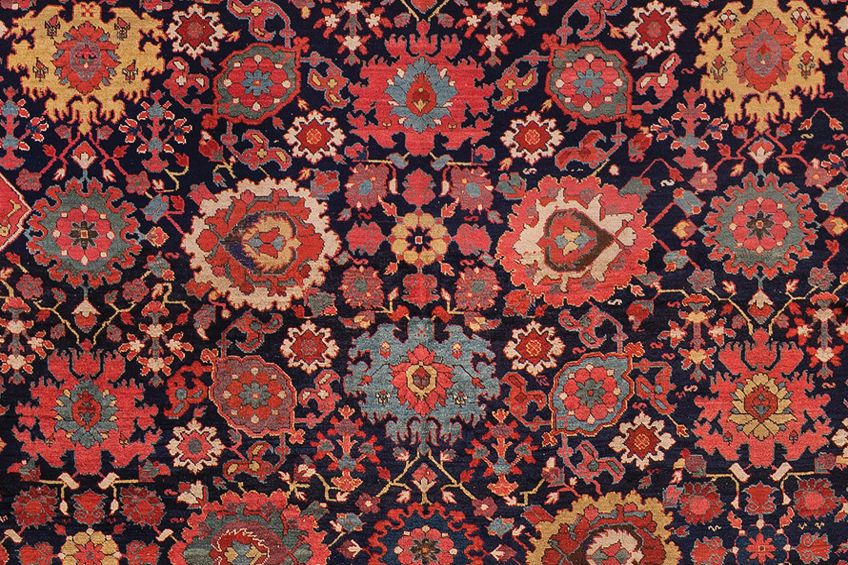
The Legacy of Ancient Persian Arts
The fall of the Sasanian Empire in 651 CE led to the rise of Islam within Iran during the 7th century CE, with this remaining the dominant religion today. Due to this, some ancient Persian religions have sadly been suppressed as time has gone on, such as the religion of Zoroastrianism. Additionally, certain Persian traditions and cultures were forced out of the way in an effort to securely establish an Islamic worldview in the developing Iran.
Despite this, aspects of Persian art and architecture managed to withstand this period of great upheaval in the country, as some of these elements went on to later influence and direct the development of Islamic artworks. Today, Iranian art still borrows heavily from past traditions that were popular during the Persian Empires, with certain aspects surfacing in various artworks that are made. An example of artistic creation that has withstood the test of time is the weaving of traditional Persian carpets.
Ancient Persian arts have a rich history, as the era has been through many periods of growth and change. Persian art and architecture have continued to maintain a powerful influence on the present-day art world. Most of the traditional artworks made typically celebrate customs of the past through using elements that worked well and improving upon them. Certain artists have even continued to work with the same materials as their ancestors did, with rugs, statues, ceramics, and textiles continuing to be among the most popular art mediums today.
Isabella studied at the University of Cape Town in South Africa and graduated with a Bachelor of Arts majoring in English Literature & Language and Psychology. Throughout her undergraduate years, she took Art History as an additional subject and absolutely loved it. Building on from her art history knowledge that began in high school, art has always been a particular area of fascination for her. From learning about artworks previously unknown to her, or sharpening her existing understanding of specific works, the ability to continue learning within this interesting sphere excites her greatly.
Her focal points of interest in art history encompass profiling specific artists and art movements, as it is these areas where she is able to really dig deep into the rich narrative of the art world. Additionally, she particularly enjoys exploring the different artistic styles of the 20th century, as well as the important impact that female artists have had on the development of art history.
Learn more about Isabella Meyer and the Art in Context Team.
Cite this Article
Isabella, Meyer, “Persian Art – A History of Ancient Persian Paintings and Iranian Art.” Art in Context. May 19, 2021. URL: https://artincontext.org/persian-art/
Meyer, I. (2021, 19 May). Persian Art – A History of Ancient Persian Paintings and Iranian Art. Art in Context. https://artincontext.org/persian-art/
Meyer, Isabella. “Persian Art – A History of Ancient Persian Paintings and Iranian Art.” Art in Context, May 19, 2021. https://artincontext.org/persian-art/.





